The Cambridge History of Japan, Vol. 1: Ancient Japan
Подождите немного. Документ загружается.

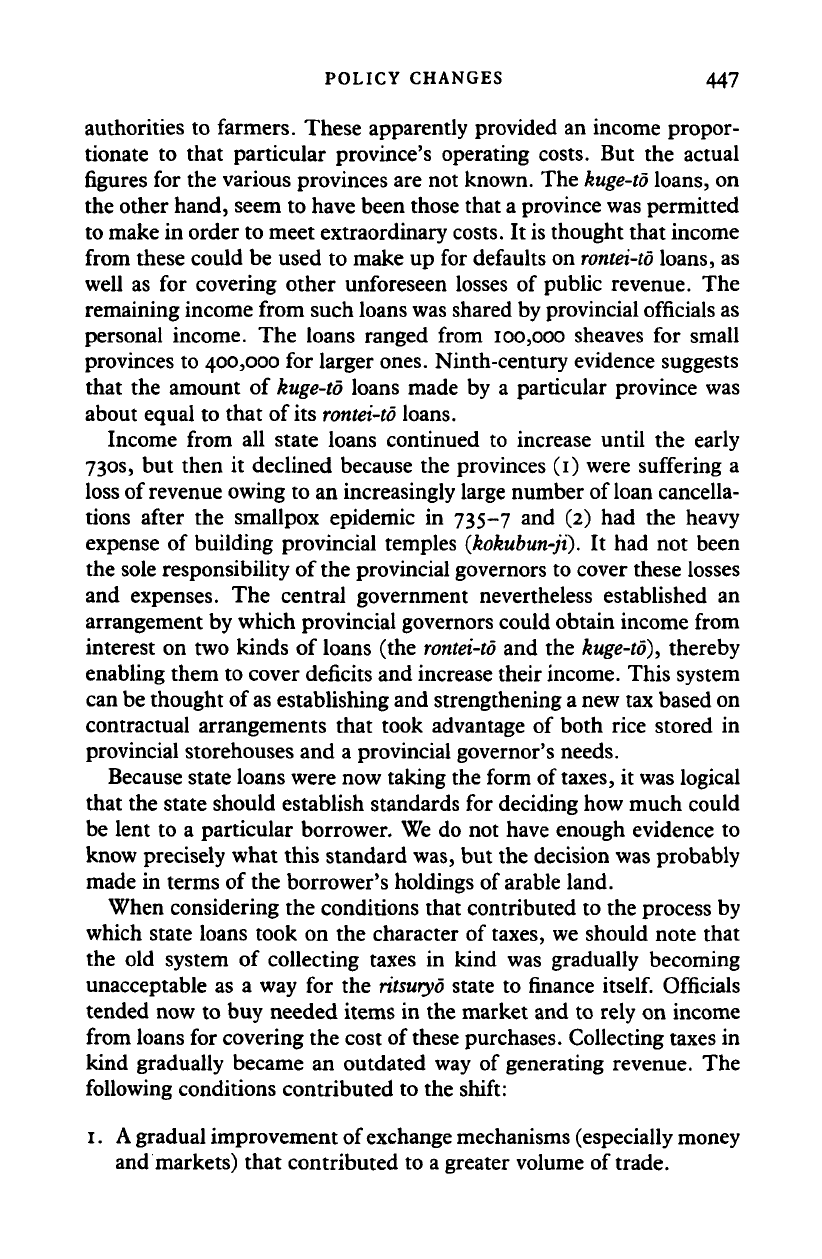
POLICY CHANGES 447
authorities to farmers. These apparently provided an income propor-
tionate to that particular province's operating costs. But the actual
figures for the various provinces are not known. The
kuge-to
loans, on
the other hand, seem to have been those that a province was permitted
to make in order to meet extraordinary costs. It is thought that income
from these could be used to make up for defaults on
rontei-to
loans, as
well as for covering other unforeseen losses of public revenue. The
remaining income from such loans was shared by provincial officials as
personal income. The loans ranged from 100,000 sheaves for small
provinces to 400,000 for larger ones. Ninth-century evidence suggests
that the amount of
kuge-to
loans made by a particular province was
about equal to that of its
rontei-to
loans.
Income from all state loans continued to increase until the early
730s,
but then it declined because the provinces (1) were suffering a
loss of revenue owing to an increasingly large number of loan cancella-
tions after the smallpox epidemic in 735-7 and (2) had the heavy
expense of building provincial temples
(kokubun-ji).
It had not been
the sole responsibility of the provincial governors to cover these losses
and expenses. The central government nevertheless established an
arrangement by which provincial governors could obtain income from
interest on two kinds of loans (the
rontei-to
and the
kuge-to),
thereby
enabling them to cover deficits and increase their income. This system
can be thought of as establishing and strengthening a new tax based on
contractual arrangements that took advantage of both rice stored in
provincial storehouses and a provincial governor's needs.
Because state loans were now taking the form of
taxes,
it was logical
that the state should establish standards for deciding how much could
be lent to a particular borrower. We do not have enough evidence to
know precisely what this standard was, but the decision was probably
made in terms of the borrower's holdings of arable land.
When considering the conditions that contributed to the process by
which state loans took on the character of taxes, we should note that
the old system of collecting taxes in kind was gradually becoming
unacceptable as a way for the
ritsuryo
state to finance
itself.
Officials
tended now to buy needed items in the market and to rely on income
from loans for covering the cost of these purchases. Collecting taxes in
kind gradually became an outdated way of generating revenue. The
following conditions contributed to the shift:
1.
A
gradual improvement of exchange mechanisms (especially money
and markets) that contributed to a greater volume of trade.
Cambridge Histories Online © Cambridge University Press, 2008
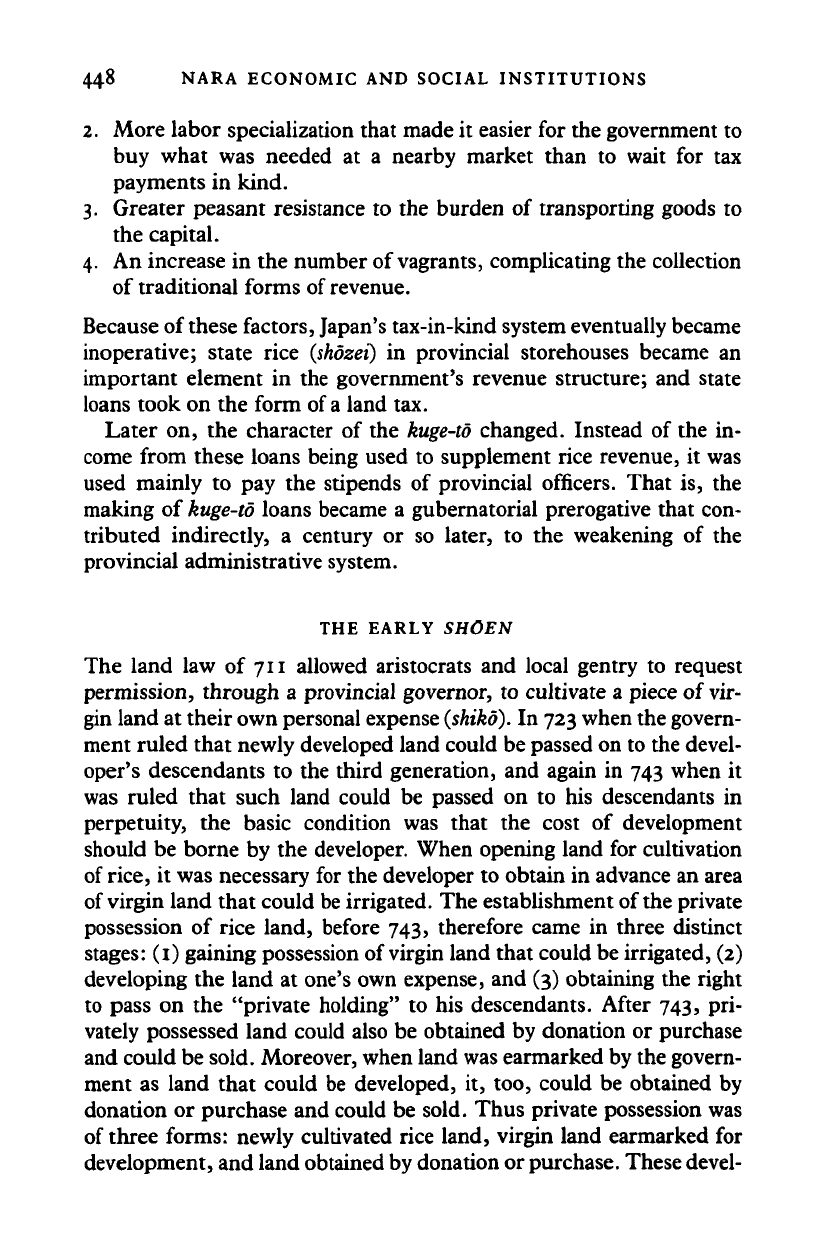
448 NARA ECONOMIC AND SOCIAL INSTITUTIONS
2.
More labor specialization that made it easier for the government to
buy what was needed at a nearby market than to wait for tax
payments in kind.
3.
Greater peasant resistance to the burden of transporting goods to
the capital.
4.
An increase in the number of
vagrants,
complicating the collection
of traditional forms of revenue.
Because of these factors, Japan's tax-in-kind system eventually became
inoperative; state rice
(shozei)
in provincial storehouses became an
important element in the government's revenue structure; and state
loans took on the form of
a
land tax.
Later on, the character of the
kuge-to
changed. Instead of the in-
come from these loans being used to supplement rice revenue, it was
used mainly to pay the stipends of provincial officers. That is, the
making of
kuge-to
loans became a gubernatorial prerogative that con-
tributed indirectly, a century or so later, to the weakening of the
provincial administrative system.
THE EARLY SHOEN
The land law of 711 allowed aristocrats and local gentry to request
permission, through a provincial governor, to cultivate a piece of vir-
gin land at their own personal expense
(shiko).
In
723
when the govern-
ment ruled that newly developed land could be passed on to the devel-
oper's descendants to the third generation, and again in 743 when it
was ruled that such land could be passed on to his descendants in
perpetuity, the basic condition was that the cost of development
should be borne by the developer. When opening land for cultivation
of rice, it was necessary for the developer to obtain in advance an area
of virgin land that could be irrigated. The establishment of the private
possession of rice land, before 743, therefore came in three distinct
stages: (1) gaining possession of virgin land that could be irrigated, (2)
developing the land at one's own expense, and (3) obtaining the right
to pass on the "private holding" to his descendants. After 743, pri-
vately possessed land could also be obtained by donation or purchase
and could be sold. Moreover, when land was earmarked by the govern-
ment as land that could be developed, it, too, could be obtained by
donation or purchase and could be sold. Thus private possession was
of three forms: newly cultivated rice land, virgin land earmarked for
development, and land obtained by donation or
purchase.
These devel-
Cambridge Histories Online © Cambridge University Press, 2008
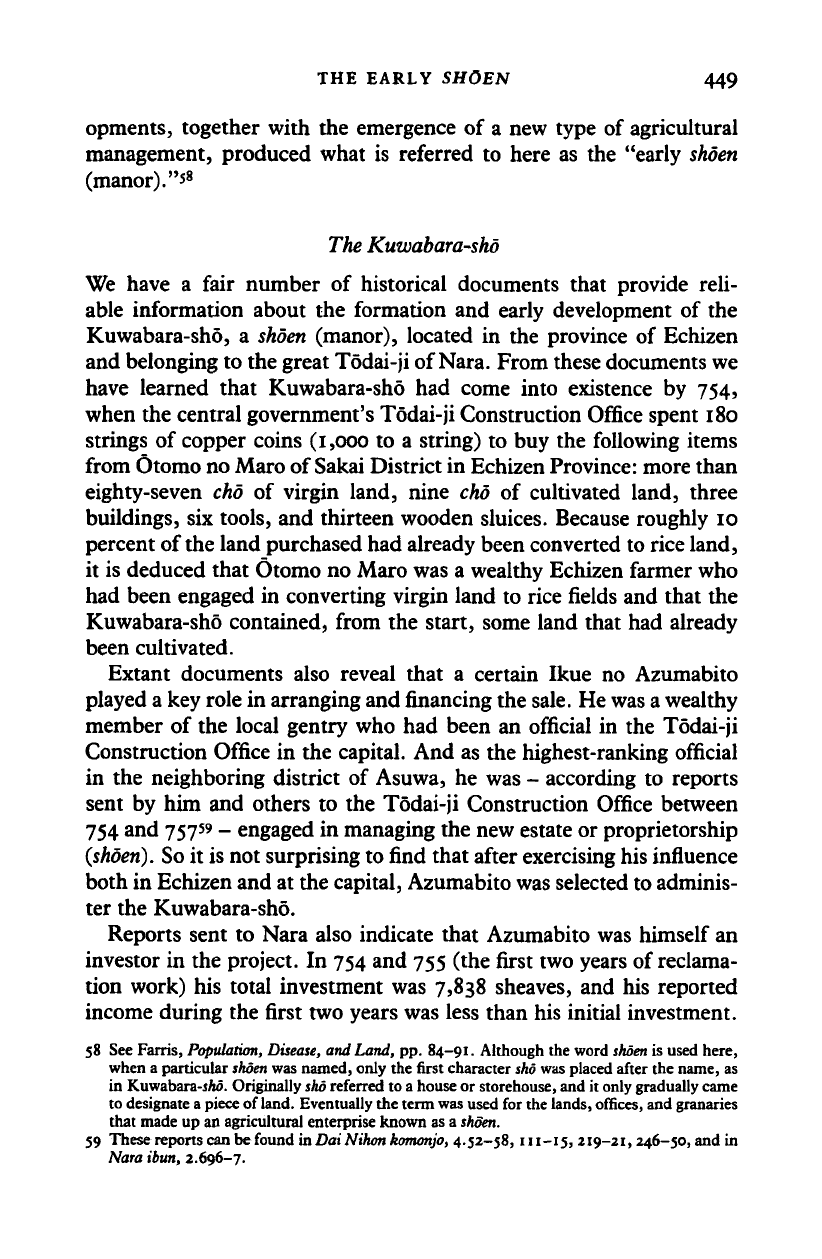
THE EARLY SHOEN 449
opments, together with the emergence of a new type of agricultural
management, produced what is referred to here as the "early
shoen
(manor).
"5
8
The Kuwabara-sho
We have a fair number of historical documents that provide reli-
able information about the formation and early development of the
Kuwabara-sho, a
shoen
(manor), located in the province of Echizen
and belonging to the great Todai-ji of Nara. From these documents we
have learned that Kuwabara-sho had come into existence by 754,
when the central government's Todai-ji Construction Office spent 180
strings of copper coins (1,000 to a string) to buy the following items
from Otomo no Maro of
Sakai
District in Echizen Province: more than
eighty-seven cho of virgin land, nine cho of cultivated land, three
buildings, six tools, and thirteen wooden sluices. Because roughly 10
percent of
the
land purchased had already been converted to rice land,
it is deduced that Otomo no Maro was a wealthy Echizen farmer who
had been engaged in converting virgin land to rice fields and that the
Kuwabara-sho contained, from the start, some land that had already
been cultivated.
Extant documents also reveal that a certain Ikue no Azumabito
played a key role in arranging and
financing
the
sale.
He was a wealthy
member of the local gentry who had been an official in the Todai-ji
Construction Office in the capital. And as the highest-ranking official
in the neighboring district of Asuwa, he was - according to reports
sent by him and others to the Todai-ji Construction Office between
754 and
75759
_ engaged in managing the new estate or proprietorship
(shoen).
So it is not surprising to find that after exercising his influence
both in Echizen and at the capital, Azumabito was selected to adminis-
ter the Kuwabara-sho.
Reports sent to Nara also indicate that Azumabito was himself an
investor in the project. In 754 and 755 (the first two years of reclama-
tion work) his total investment was
7,838
sheaves, and his reported
income during the first two years was less than his initial investment.
58 See Farris, Population, Disease, and
Land,
pp.
84-91.
Although the word
shoen
is used here,
when a particular
shoen
was named, only the first character
sho
was placed after the name, as
in Kuwabara-iAo. Originally
sho
referred to a house or storehouse, and it only gradually came
to designate a piece of
land.
Eventually the term was used for the lands, offices, and granaries
that made up an agricultural enterprise known as a shorn.
59 These reports can be found in Dai Nihon
komonjo,
4.52-58,111-15, 219-21,246-50, and in
Nara ibun, 2.696-7.
Cambridge Histories Online © Cambridge University Press, 2008
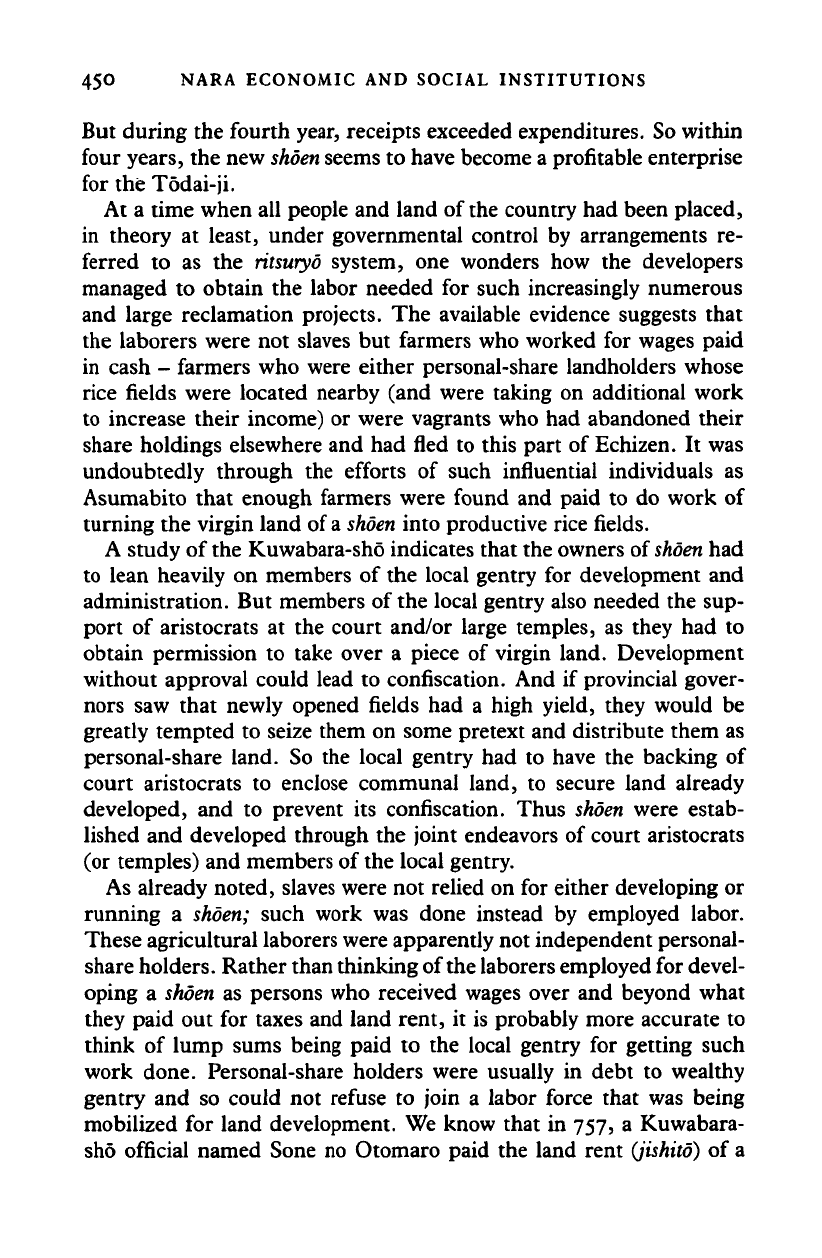
450 NARA ECONOMIC AND SOCIAL INSTITUTIONS
But during the fourth year, receipts exceeded expenditures. So within
four years, the new
shoen
seems to have become a profitable enterprise
for the T6dai-ji.
At a time when all people and land of the country had been placed,
in theory at least, under governmental control by arrangements re-
ferred to as the ritsuryo system, one wonders how the developers
managed to obtain the labor needed for such increasingly numerous
and large reclamation projects. The available evidence suggests that
the laborers were not slaves but farmers who worked for wages paid
in cash - farmers who were either personal-share landholders whose
rice fields were located nearby (and were taking on additional work
to increase their income) or were vagrants who had abandoned their
share holdings elsewhere and had fled to this part of Echizen. It was
undoubtedly through the efforts of such influential individuals as
Asumabito that enough farmers were found and paid to do work of
turning the virgin land of
a shoen
into productive rice fields.
A study of the Kuwabara-sho indicates that the owners of
shoen
had
to lean heavily on members of the local gentry for development and
administration. But members of the local gentry also needed the sup-
port of aristocrats at the court and/or large temples, as they had to
obtain permission to take over a piece of virgin land. Development
without approval could lead to confiscation. And if provincial gover-
nors saw that newly opened fields had a high yield, they would be
greatly tempted to seize them on some pretext and distribute them as
personal-share land. So the local gentry had to have the backing of
court aristocrats to enclose communal land, to secure land already
developed, and to prevent its confiscation. Thus
shoen
were estab-
lished and developed through the joint endeavors of court aristocrats
(or temples) and members of the local gentry.
As already noted, slaves were not relied on for either developing or
running a shoen; such work was done instead by employed labor.
These agricultural laborers were apparently not independent personal-
share holders. Rather than thinking of the laborers employed for devel-
oping a
shoen
as persons who received wages over and beyond what
they paid out for taxes and land rent, it is probably more accurate to
think of lump sums being paid to the local gentry for getting such
work done. Personal-share holders were usually in debt to wealthy
gentry and so could not refuse to join a labor force that was being
mobilized for land development. We know that in 757, a Kuwabara-
sho official named Sone no Otomaro paid the land rent
(jishito)
of a
Cambridge Histories Online © Cambridge University Press, 2008
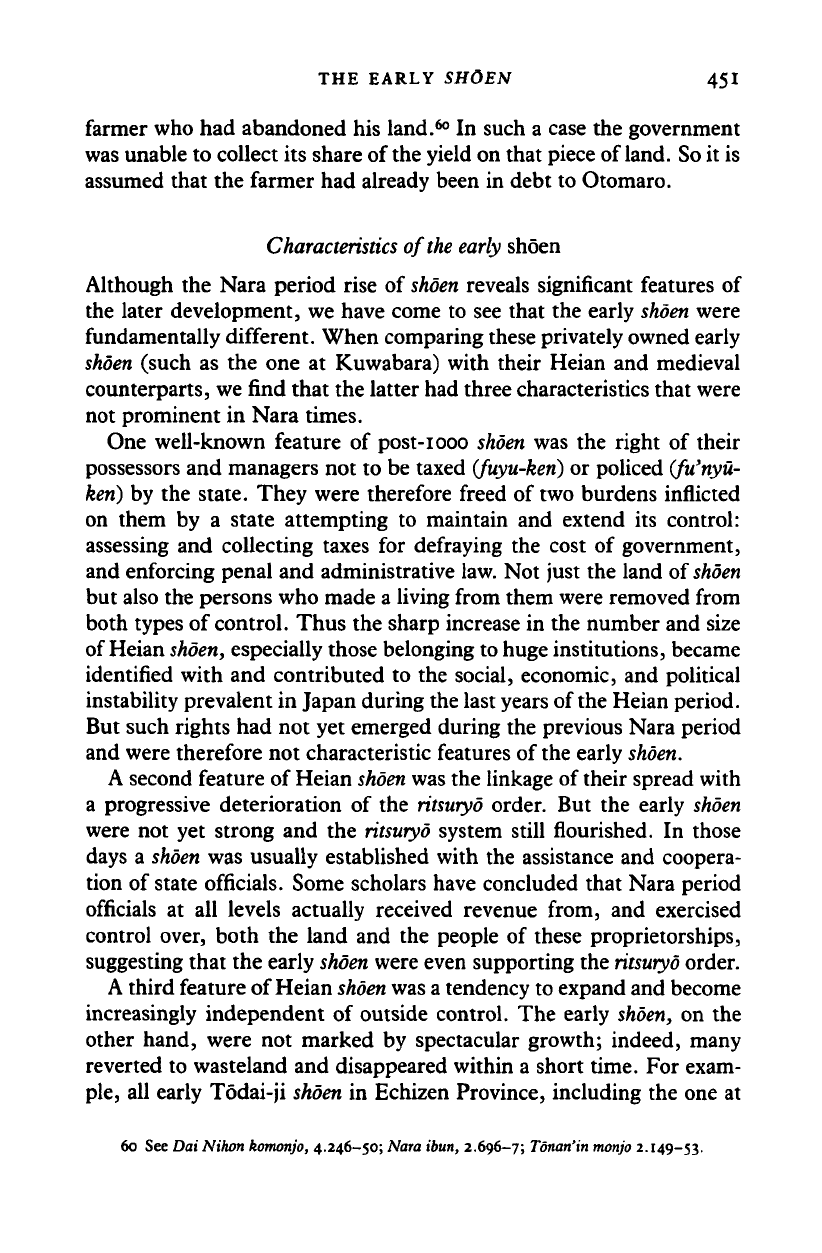
THE EARLY SHOEN 451
farmer who had abandoned his land.
60
In such a case the government
was unable to collect its share of
the
yield on that piece of land.
So
it is
assumed that the farmer had already been in debt to Otomaro.
Characteristics
of the early shoen
Although the Nara period rise of
shoen
reveals significant features of
the later development, we have come to see that the early
shoen
were
fundamentally different. When comparing these privately owned early
shoen
(such as the one at Kuwabara) with their Heian and medieval
counterparts, we find that the latter had three characteristics that were
not prominent in Nara times.
One well-known feature of post-iooo
shoen
was the right of their
possessors and managers not to be taxed
(fuyu-keri)
or policed (fu'nyu-
ken) by the state. They were therefore freed of two burdens inflicted
on them by a state attempting to maintain and extend its control:
assessing and collecting taxes for defraying the cost of government,
and enforcing penal and administrative law. Not just the land of
shoen
but also the persons who made a living from them were removed from
both types of control. Thus the sharp increase in the number and size
of Heian
shoen,
especially those belonging to huge institutions, became
identified with and contributed to the social, economic, and political
instability prevalent in Japan during the last years of
the
Heian period.
But such rights had not yet emerged during the previous Nara period
and were therefore not characteristic features of the early
shoen.
A second feature of Heian
shoen
was the linkage of their spread with
a progressive deterioration of the ritsuryo order. But the early
shoen
were not yet strong and the
ritsuryo
system still flourished. In those
days a
shoen
was usually established with the assistance and coopera-
tion of state officials. Some scholars have concluded that Nara period
officials at all levels actually received revenue from, and exercised
control over, both the land and the people of these proprietorships,
suggesting that the early
shoen
were even supporting the
ritsuryo
order.
A third feature of Heian
shoen
was a tendency to expand and become
increasingly independent of outside control. The early
shoen,
on the
other hand, were not marked by spectacular growth; indeed, many
reverted to wasteland and disappeared within a short time. For exam-
ple,
all early T6dai-ji
shoen
in Echizen Province, including the one at
60 See Dai Nihon komonjo, 4.246-50; Nara ibun, 2.696—7;
Tonan'in monjo
2.149—53.
Cambridge Histories Online © Cambridge University Press, 2008
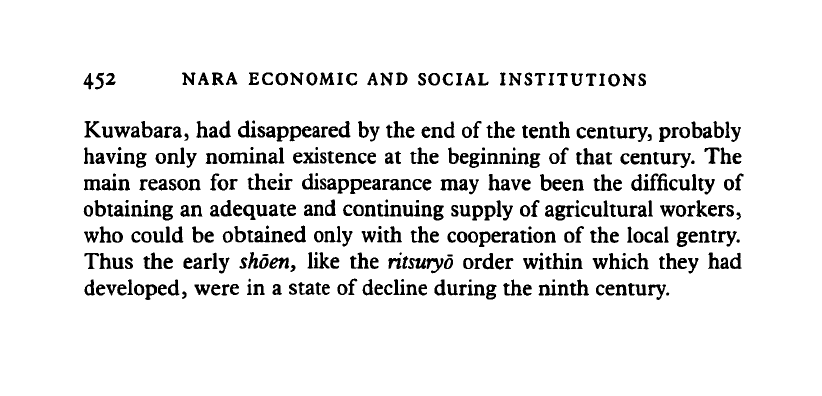
452 NARA ECONOMIC AND SOCIAL INSTITUTIONS
Kuwabara, had disappeared by the end of the tenth century, probably
having only nominal existence at the beginning of that century. The
main reason for their disappearance may have been the difficulty of
obtaining an adequate and continuing supply of agricultural workers,
who could be obtained only with the cooperation of the local gentry.
Thus the early shorn, like the ritsuryo order within which they had
developed, were in a state of decline during the ninth century.
Cambridge Histories Online © Cambridge University Press, 2008
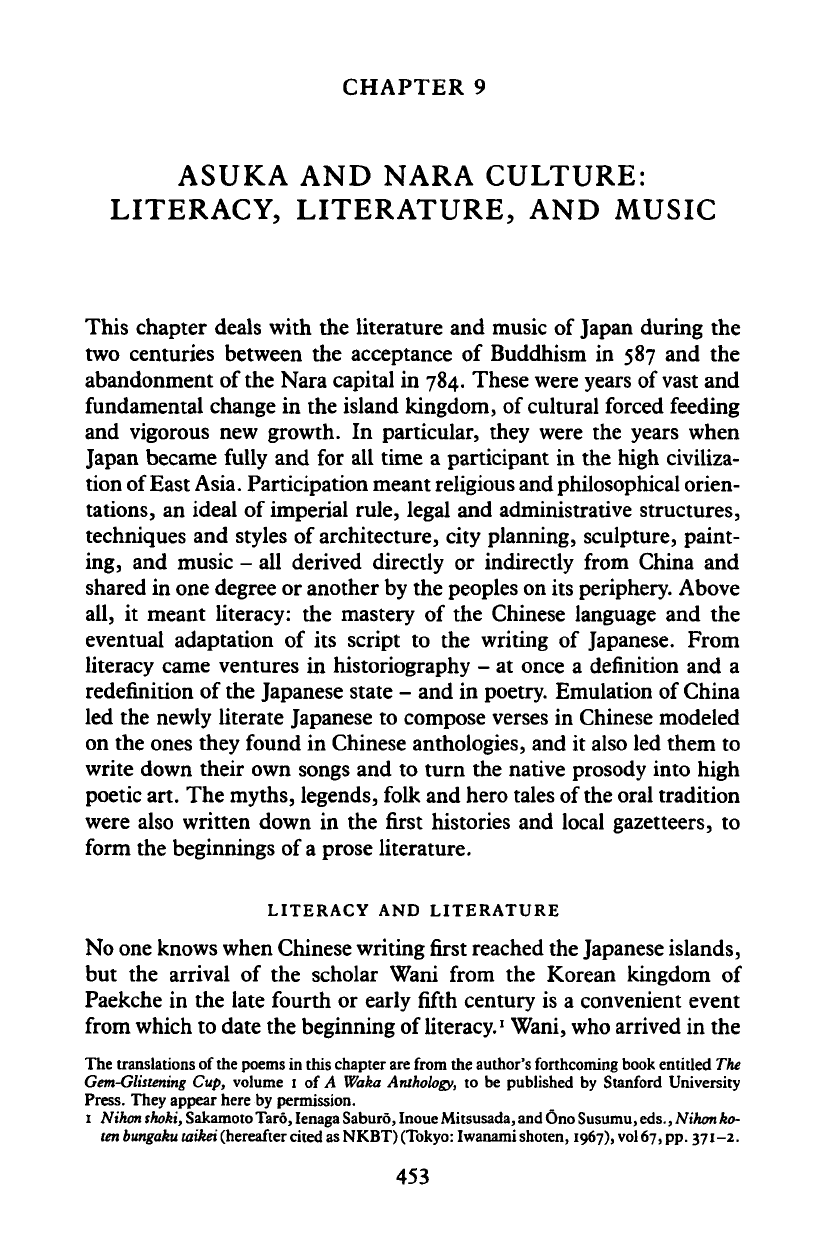
CHAPTER 9
ASUKA AND NARA CULTURE:
LITERACY, LITERATURE, AND MUSIC
This chapter deals with the literature and music of Japan during the
two centuries between the acceptance of Buddhism in 587 and the
abandonment of the Nara capital in 784. These were years of vast and
fundamental change in the island kingdom, of cultural forced feeding
and vigorous new growth. In particular, they were the years when
Japan became fully and for all time a participant in the high civiliza-
tion of East
Asia.
Participation meant religious and philosophical orien-
tations, an ideal of imperial rule, legal and administrative structures,
techniques and styles of architecture, city planning, sculpture, paint-
ing, and music - all derived directly or indirectly from China and
shared in one degree or another by the peoples on its periphery. Above
all,
it meant literacy: the mastery of the Chinese language and the
eventual adaptation of its script to the writing of Japanese. From
literacy came ventures in historiography - at once a definition and a
redefinition of the Japanese state - and in poetry. Emulation of China
led the newly literate Japanese to compose verses in Chinese modeled
on the ones they found in Chinese anthologies, and it also led them to
write down their own songs and to turn the native prosody into high
poetic art. The myths, legends, folk and hero tales of
the
oral tradition
were also written down in the first histories and local gazetteers, to
form the beginnings of
a
prose literature.
LITERACY AND LITERATURE
No one knows when Chinese writing first reached the Japanese islands,
but the arrival of the scholar Wani from the Korean kingdom of
Paekche in the late fourth or early fifth century is a convenient event
from which to date the beginning of
literacy.
1
Wani, who arrived in the
The translations of the poems in this chapter are from the author's fonhcoming book entitled
The
Gem-Glistening
Cup, volume I of A
Waka
Anthology,
to be published by Stanford University
Press.
They appear here by permission.
1
Nihon
shoki,
Sakamoto
Taro,
Ienaga
Saburo,
Inoue Mitsusada, and
Ono
Susumu,
eds.,
Nihon
ko-
ten bungaku taikei
(hereafter cited
as
NKBT)
(Tokyo:
Iwanami
shoten,
1967),
vol
67,
pp.
371
-2.
453
Cambridge Histories Online © Cambridge University Press, 2008
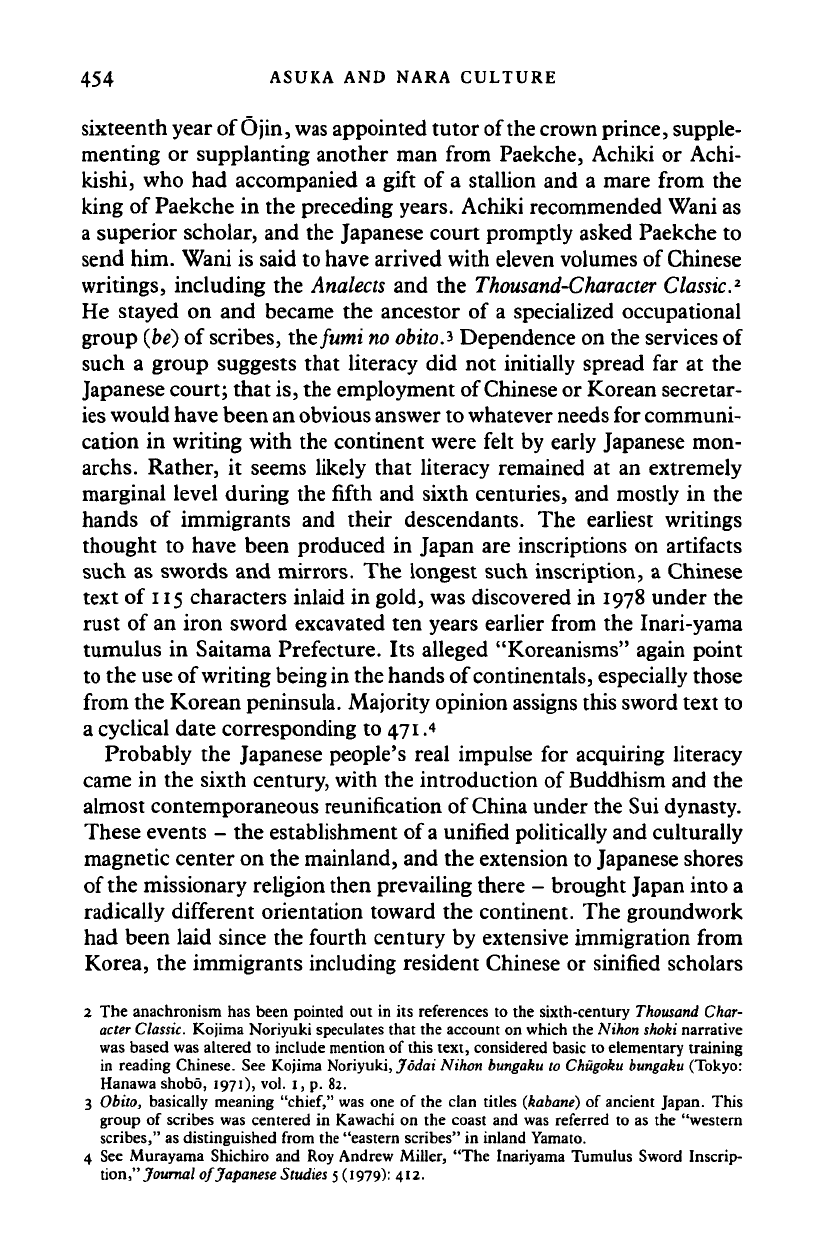
454 ASUKA AND NARA CULTURE
sixteenth year of Ojin,
was
appointed tutor of the crown prince, supple-
menting or supplanting another man from Paekche, Achiki or Achi-
kishi, who had accompanied a gift of a stallion and a mare from the
king of Paekche in the preceding years. Achiki recommended Wani as
a superior scholar, and the Japanese court promptly asked Paekche to
send him. Wani is said to have arrived with eleven volumes of Chinese
writings, including the
Analects
and the
Thousand-Character
Classic.
2
He stayed on and became the ancestor of a specialized occupational
group
(be)
of
scribes,
the fumi
no
obitoJ Dependence on the services of
such a group suggests that literacy did not initially spread far at the
Japanese court; that
is,
the employment of Chinese or Korean secretar-
ies
would have been an
obvious
answer
to
whatever needs for communi-
cation in writing with the continent were felt by early Japanese mon-
archs.
Rather, it seems likely that literacy remained at an extremely
marginal level during the fifth and sixth centuries, and mostly in the
hands of immigrants and their descendants. The earliest writings
thought to have been produced in Japan are inscriptions on artifacts
such as swords and mirrors. The longest such inscription, a Chinese
text of 115 characters inlaid in gold, was discovered in 1978 under the
rust of an iron sword excavated ten years earlier from the Inari-yama
tumulus in Saitama Prefecture. Its alleged "Koreanisms" again point
to the use of writing being in the hands of continentals, especially those
from the Korean peninsula. Majority opinion assigns this sword text to
a cyclical date corresponding to 471.4
Probably the Japanese people's real impulse for acquiring literacy
came in the sixth century, with the introduction of Buddhism and the
almost contemporaneous reunification of China under the Sui dynasty.
These events - the establishment of a unified politically and culturally
magnetic center on the mainland, and the extension to Japanese shores
of the missionary religion then prevailing there - brought Japan into a
radically different orientation toward the continent. The groundwork
had been laid since the fourth century by extensive immigration from
Korea, the immigrants including resident Chinese or sinified scholars
2 The anachronism has been pointed out in its references to the sixth-century Thousand Char-
acter Classic. Kojima Noriyuki speculates that the account on which the Nihon shoki narrative
was based was altered to include mention of this text, considered basic to elementary training
in reading Chinese. See Kojima Noriyuki, Jodai Nihon bungaku to Chugoku bungaku (Tokyo:
Hanawa shobo, 1971), vol. 1, p. 82.
3 Obito, basically meaning
"chief,"
was one of the clan titles (kabane) of ancient Japan. This
group of scribes was centered in Kawachi on the coast and was referred to as the "western
scribes," as distinguished from the "eastern scribes" in inland Yamato.
4 See Murayama Shichiro and Roy Andrew Miller, "The Inariyama Tumulus Sword Inscrip-
tion," Journal of Japanese Studies
5
(1979): 412.
Cambridge Histories Online © Cambridge University Press, 2008
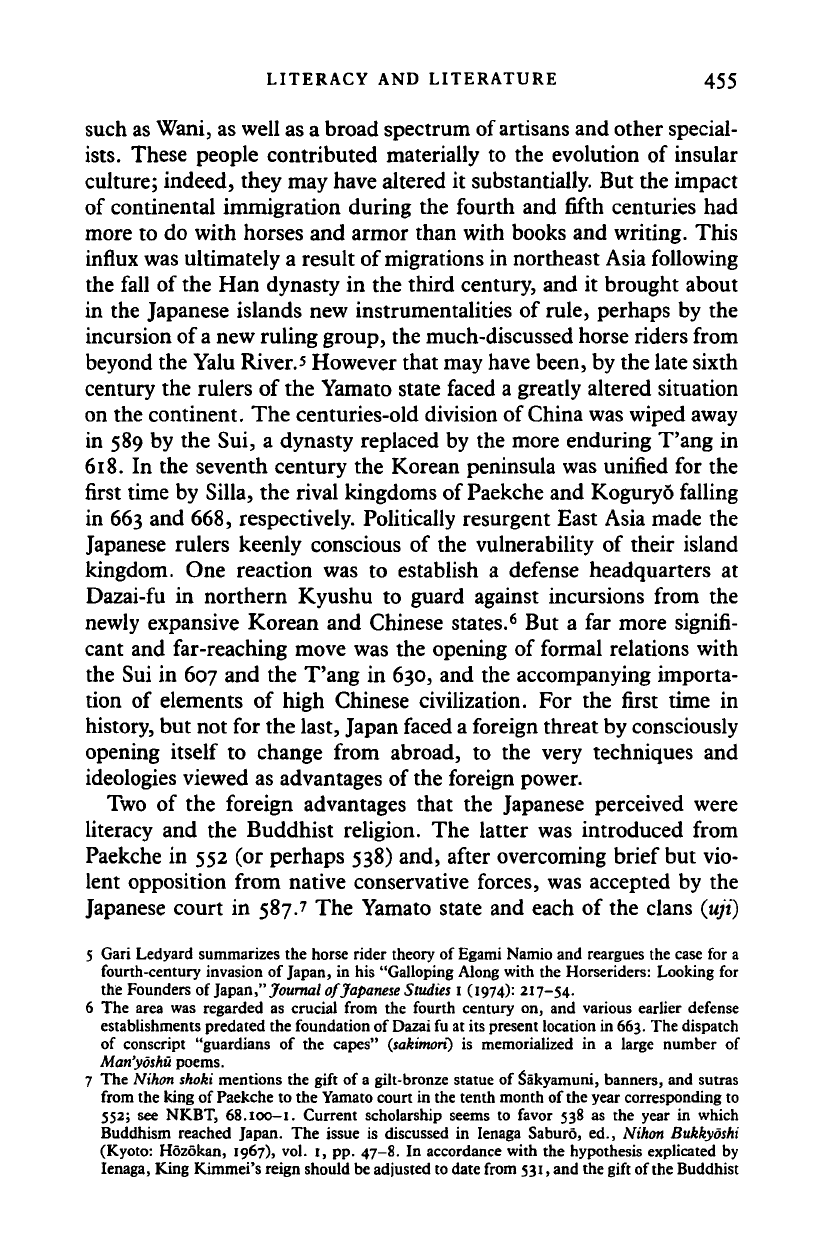
LITERACY AND LITERATURE 455
such as Wani, as well as a broad spectrum of artisans and other special-
ists.
These people contributed materially to the evolution of insular
culture; indeed, they may have altered it substantially. But the impact
of continental immigration during the fourth and fifth centuries had
more to do with horses and armor than with books and writing. This
influx was ultimately a result of migrations in northeast Asia following
the fall of the Han dynasty in the third century, and it brought about
in the Japanese islands new instrumentalities of rule, perhaps by the
incursion of
a
new ruling group, the much-discussed horse riders from
beyond the Yalu River.
5
However that may have been, by the late sixth
century the rulers of the Yamato state faced a greatly altered situation
on the continent. The centuries-old division of China was wiped away
in 589 by the Sui, a dynasty replaced by the more enduring T'ang in
618.
In the seventh century the Korean peninsula was unified for the
first time by Silla, the rival kingdoms of Paekche and Koguryo falling
in 663 and 668, respectively. Politically resurgent East Asia made the
Japanese rulers keenly conscious of the vulnerability of their island
kingdom. One reaction was to establish a defense headquarters at
Dazai-fu in northern Kyushu to guard against incursions from the
newly expansive Korean and Chinese states.
6
But a far more signifi-
cant and far-reaching move was the opening of formal relations with
the Sui in 607 and the T'ang in 630, and the accompanying importa-
tion of elements of high Chinese civilization. For the first time in
history, but not for the last, Japan faced a foreign threat by consciously
opening itself to change from abroad, to the very techniques and
ideologies viewed as advantages of the foreign power.
Two of the foreign advantages that the Japanese perceived were
literacy and the Buddhist religion. The latter was introduced from
Paekche in 552 (or perhaps 538) and, after overcoming brief but vio-
lent opposition from native conservative forces, was accepted by the
Japanese court in 587.7 The Yamato state and each of the clans (uji)
5 Gari Ledyard summarizes the horse rider theory of Egami Namio and reargues the case for a
fourth-century invasion of Japan, in his "Galloping Along with the Horseriders: Looking for
the Founders of
Japan,"
Journal ofJapanese Studies 1 (1974): 217-54.
6 The area was regarded as crucial from the fourth century on, and various earlier defense
establishments predated the foundation of Dazai fu at its present location in 663. The dispatch
of conscript "guardians of the capes" (sakinwri) is memorialized in a large number of
Man'yoshu
poems.
7 The Nihon shoki mentions the gift of a gilt-bronze statue of Sakyamuni, banners, and sutras
from the king of Paekche to the Yamato court in the tenth month of the year corresponding to
552;
see NKBT, 68.100-1. Current scholarship seems to favor 538 as the year in which
Buddhism reached Japan. The issue is discussed in Ienaga Saburo, ed., Nihon Bukkyosht
(Kyoto: Hozokan, 1967), vol. 1, pp. 47-8. In accordance with the hypothesis explicated by
Ienaga, King Kimmei's reign should be adjusted to date from 531, and the gift of the Buddhist
Cambridge Histories Online © Cambridge University Press, 2008
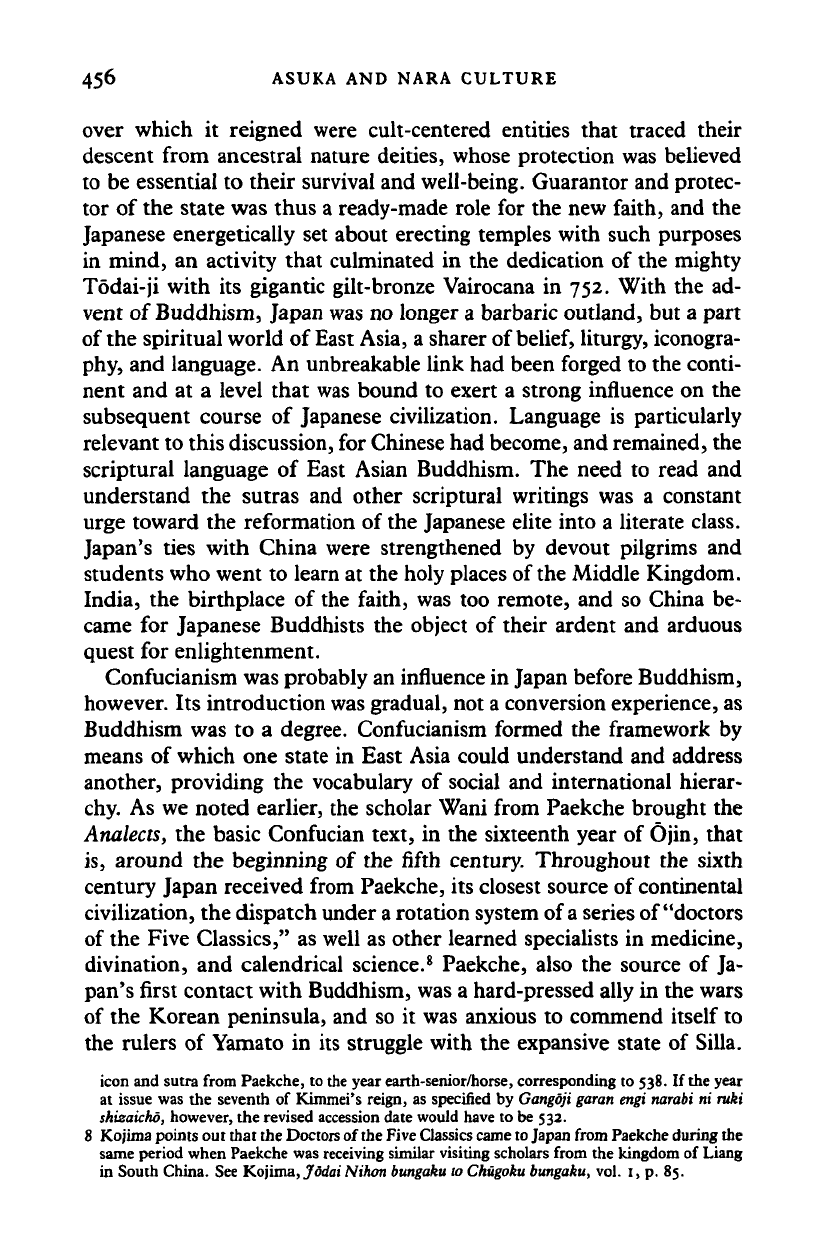
456 ASUKA AND NARA CULTURE
over which it reigned were cult-centered entities that traced their
descent from ancestral nature deities, whose protection was believed
to be essential to their survival and well-being. Guarantor and protec-
tor of the state was thus a ready-made role for the new faith, and the
Japanese energetically set about erecting temples with such purposes
in mind, an activity that culminated in the dedication of the mighty
T6dai-ji with its gigantic gilt-bronze Vairocana in 752. With the ad-
vent of Buddhism, Japan was no longer a barbaric outland, but a part
of the spiritual world of East Asia, a sharer of
belief,
liturgy, iconogra-
phy, and language. An unbreakable link had been forged to the conti-
nent and at a level that was bound to exert a strong influence on the
subsequent course of Japanese civilization. Language is particularly
relevant to this discussion, for Chinese had become, and remained, the
scriptural language of East Asian Buddhism. The need to read and
understand the sutras and other scriptural writings was a constant
urge toward the reformation of the Japanese elite into a literate class.
Japan's ties with China were strengthened by devout pilgrims and
students who went to learn at the holy places of the Middle Kingdom.
India, the birthplace of the faith, was too remote, and so China be-
came for Japanese Buddhists the object of their ardent and arduous
quest for enlightenment.
Confucianism was probably an influence in Japan before Buddhism,
however. Its introduction was gradual, not a conversion experience, as
Buddhism was to a degree. Confucianism formed the framework by
means of which one state in East Asia could understand and address
another, providing the vocabulary of social and international hierar-
chy. As we noted earlier, the scholar Wani from Paekche brought the
Analects, the basic Confucian text, in the sixteenth year of Ojin, that
is,
around the beginning of the fifth century. Throughout the sixth
century Japan received from Paekche, its closest source of continental
civilization, the dispatch under
a
rotation system of a series of "doctors
of the Five Classics," as well as other learned specialists in medicine,
divination, and calendrical science.
8
Paekche, also the source of Ja-
pan's first contact with Buddhism, was a hard-pressed ally in the wars
of the Korean peninsula, and so it was anxious to commend itself to
the rulers of Yamato in its struggle with the expansive state of Silla.
icon and sutra from Paekche, to the year earth-senior/horse, corresponding to
538.
If the year
at issue was the seventh of Kimmei's reign, as specified by
Gangoji garan engi narabi
ni
ruki
shizaicho,
however, the revised accession date would have to be 532.
8 Kojima points out that the Doctors of the Five
Classics came to
Japan from Paekche during the
same period when Paekche was receiving similar visiting scholars from the kingdom of Liang
in South China. See Kojima, JodaiNihon
bungaku to Chugoku
bungaku,
vol. I, p. 85.
Cambridge Histories Online © Cambridge University Press, 2008
